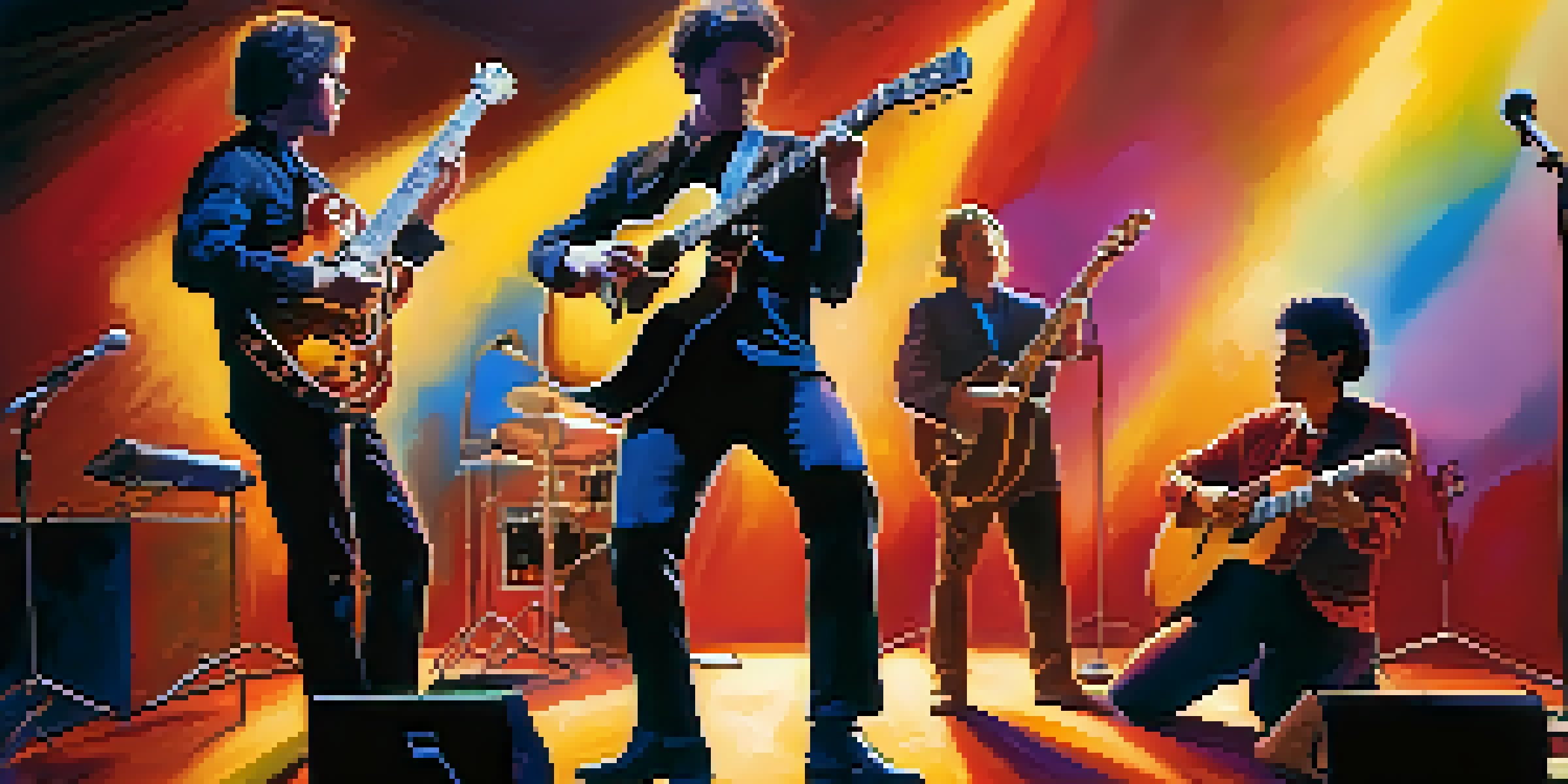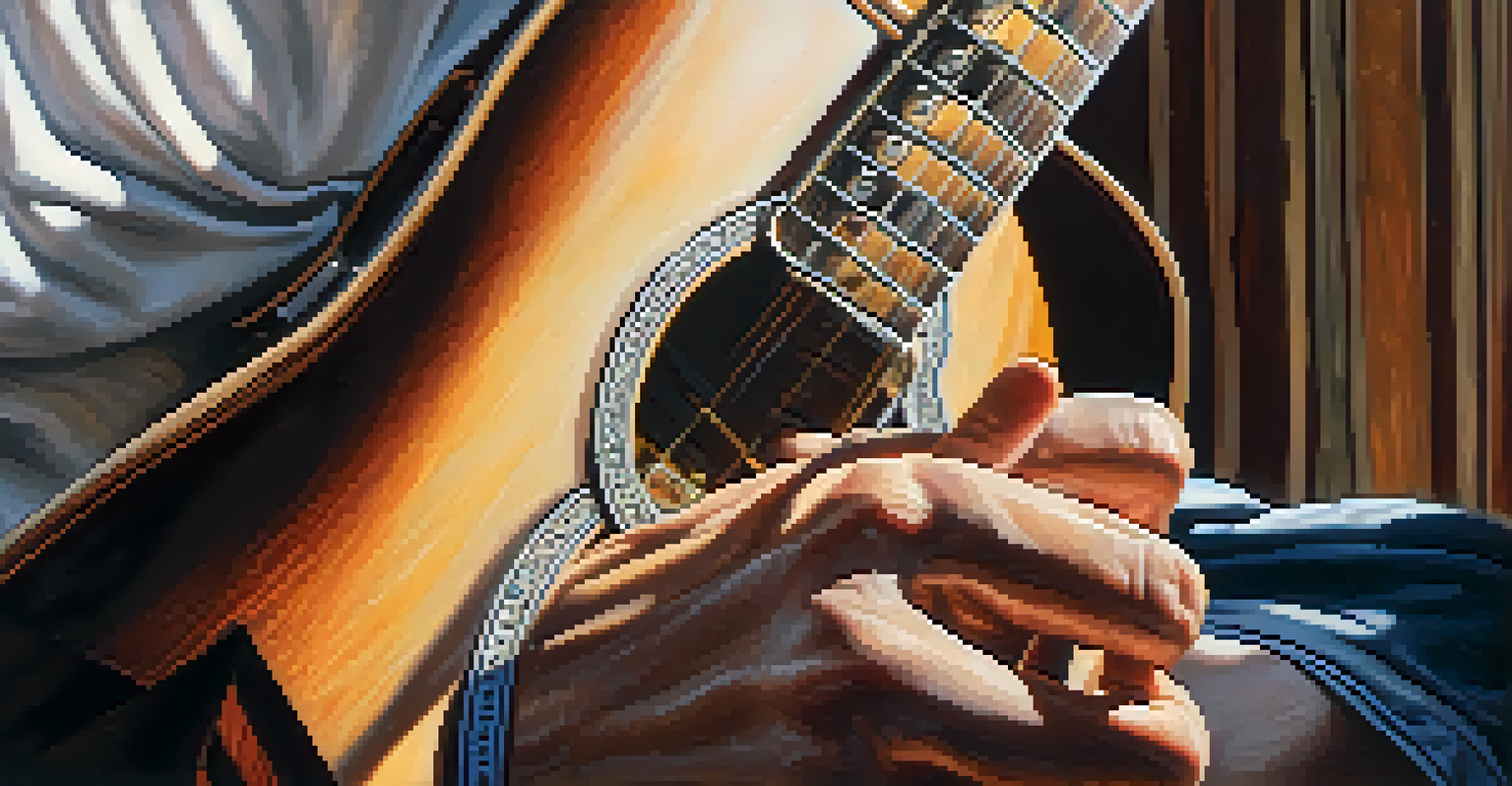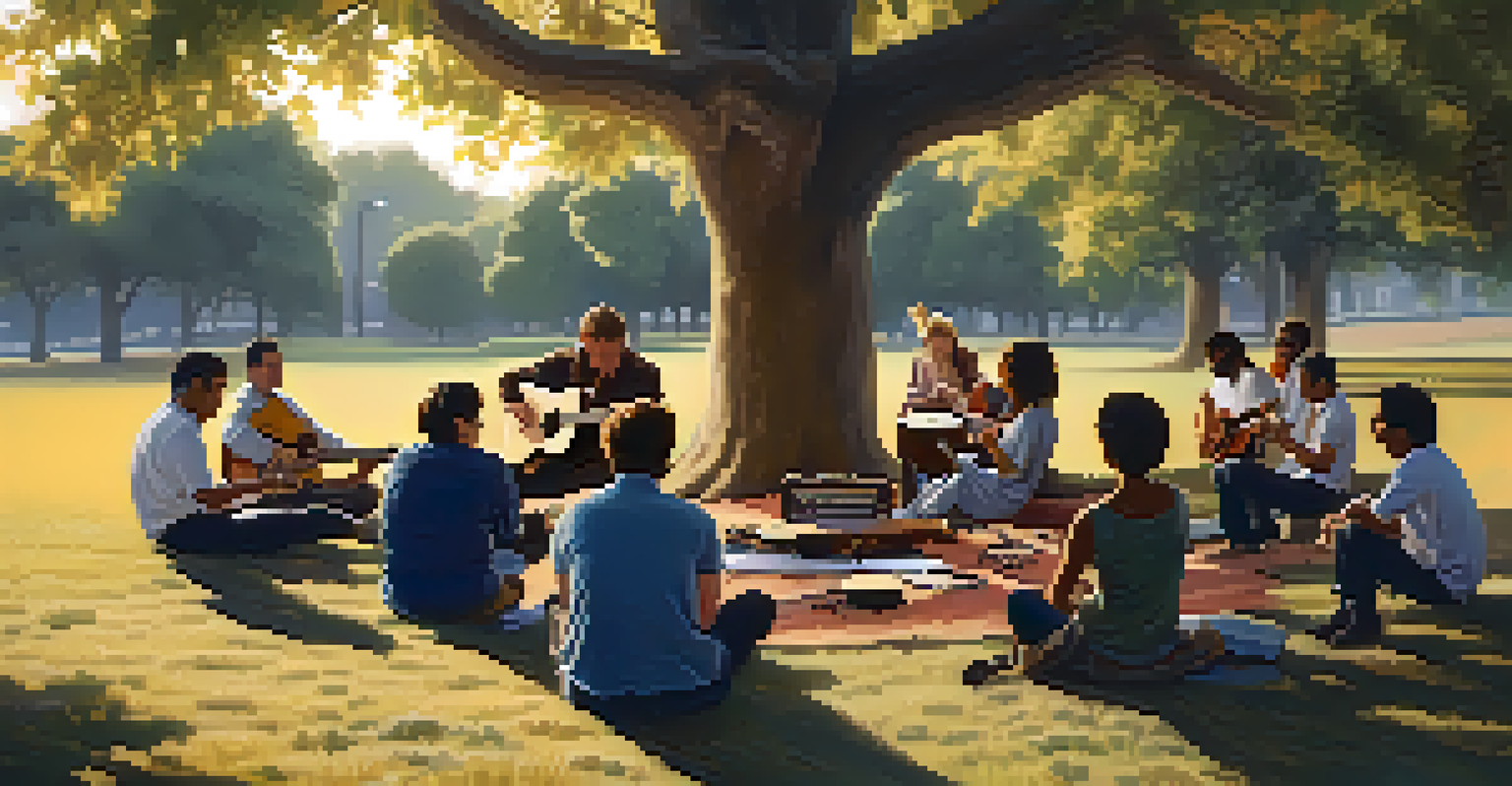Using Rhythm to Enhance Guitar Ensemble Performances

Understanding the Role of Rhythm in Music
Rhythm is the heartbeat of music, providing structure and flow to compositions. In a guitar ensemble, rhythm helps unify the players, ensuring they move together as one cohesive unit. Think of rhythm as a dance floor where each guitarist has a specific role, contributing to a larger performance.
Rhythm is the soul of music, a heartbeat that connects players and captivates listeners.
When rhythm is tightly woven into the fabric of a piece, it allows for dynamic interactions among musicians. For instance, a syncopated rhythm can create tension and excitement, inviting players to engage more deeply with each other. This engagement not only enhances the sound but also enriches the performance experience.
Ultimately, understanding rhythm is crucial for any guitarist looking to perform in an ensemble. It guides timing, interaction, and expression, serving as a bridge that connects individual musicians to the collective sound. Without rhythm, even the most skilled players can struggle to create a harmonious performance.
Establishing a Strong Rhythm Foundation
Before diving into a performance, it’s essential to establish a strong rhythmic foundation. This can be achieved through consistent practice of scales and exercises that emphasize timing. For example, using a metronome during practice helps guitarists develop a steady pulse, which is vital in ensemble settings.

Incorporating clapping or tapping exercises can also reinforce rhythm awareness. By clapping out the beats together, ensemble members can synchronize their internal clocks and feel the pulse collectively. This simple activity can significantly improve coordination and timing when they pick up their guitars.
Rhythm Unifies Guitar Ensembles
A strong rhythmic foundation helps musicians synchronize their playing, creating a cohesive and engaging performance.
Finally, consider starting rehearsals with a dedicated warm-up focusing solely on rhythm. Whether it’s playing a simple chord progression or a rhythmic pattern, this practice sets the tone for the session and helps everyone align their playing with the established rhythm.
Exploring Different Rhythmic Patterns
Variety is the spice of life—and music! By exploring different rhythmic patterns, guitar ensembles can create a more engaging performance. Whether it’s straight eighths, triplets, or polyrhythms, each pattern brings its own flavor and complexity to the music.
Music is the shorthand of emotion, and rhythm is its pulse.
For example, introducing a 6/8 rhythm can evoke a lively, dance-like feel, while a 4/4 pattern might create a more grounded groove. Encouraging ensemble members to experiment with these patterns can lead to a richer texture in the music. It’s like adding different spices to a dish, transforming a simple recipe into a culinary masterpiece.
As members become comfortable with various patterns, they can start to blend them creatively. This not only enhances the overall sound but also encourages improvisation, allowing each musician to express themselves while staying connected to the group. The result? A vibrant and dynamic performance that captivates the audience.
Implementing Rhythmic Dynamics in Performance
Rhythmic dynamics play a crucial role in enhancing the expressiveness of a guitar ensemble. By varying the intensity of playing—such as strumming softer or louder at different moments—musicians can create a sense of contrast and excitement. This technique keeps the audience engaged and adds depth to the performance.
Consider a scenario where the ensemble starts softly with a gentle rhythm and gradually builds to a powerful crescendo. This dynamic shift not only captures attention but also adds an emotional arc to the piece. It’s much like a story that ebbs and flows, leading listeners on a journey.
Explore Varied Rhythmic Patterns
Incorporating different rhythmic patterns adds interest and complexity, enhancing the overall texture of the music.
Encouraging ensemble members to communicate during the performance can also heighten rhythmic dynamics. Subtle cues, like nodding or eye contact, allow musicians to respond to each other's playing, creating a spontaneous and lively interaction. This shared experience adds an extra layer of connection, both among the players and with the audience.
Tuning into Each Other’s Rhythms
In a guitar ensemble, listening to one another is just as vital as playing your part. When musicians attune themselves to each other's rhythms, they can create a more cohesive and polished performance. This listening skills are essential for ensuring that everyone stays in sync and maintains the intended feel of the music.
One effective way to foster this connection is through call-and-response exercises. In these activities, one player sets a rhythmic pattern that others imitate, promoting active listening and interaction. This not only builds ensemble cohesion but also enhances individual rhythmic skills.
Additionally, encouraging open communication about rhythm during rehearsals can help all members feel comfortable sharing their thoughts. Whether it’s discussing what feels strong or suggesting adjustments, this dialogue cultivates a collaborative environment where everyone contributes to the rhythmic foundation.
Creating Rhythmic Variation for Interest
Rhythmic variation is a powerful tool that can keep performances fresh and exciting. By incorporating different rhythmic motifs or altering existing ones, guitarists can maintain listener interest throughout a piece. Just like a good book that introduces unexpected twists, rhythmic variation can make a performance memorable.
For instance, consider varying a repeated riff by changing its rhythm or adding embellishments. This subtle shift can breathe new life into a familiar section, inviting the audience to engage more deeply with the music. It’s akin to adding new chapters to a favorite story, ensuring it never feels stale.
Practice Together for Better Timing
Regular ensemble practice focused on rhythm fosters unity and improves collective timing and coordination.
Encouraging ensemble members to contribute their ideas for rhythmic variations can also foster creativity. Each musician brings their unique perspective, leading to innovative solutions that enhance the overall performance. Together, these variations can create a rich tapestry of sound that captivates both the performers and the audience.
Practicing Rhythm Together as an Ensemble
Regular ensemble practice is essential for honing rhythmic skills collectively. Setting aside dedicated time to focus on rhythm allows musicians to refine their timing and coordination together. This shared commitment builds camaraderie and strengthens the ensemble's overall sound.
Incorporating rhythm drills into practice sessions can be particularly beneficial. These drills can range from simple clapping exercises to more complex rhythmic compositions. Engaging in these activities not only sharpens individual skills but also fosters a sense of unity within the group.

Finally, recording practice sessions can provide valuable feedback on rhythmic performance. Listening back allows ensembles to identify areas for improvement and celebrate their successes. This reflective practice cultivates a growth mindset, ensuring that every performance is an opportunity to learn and evolve.